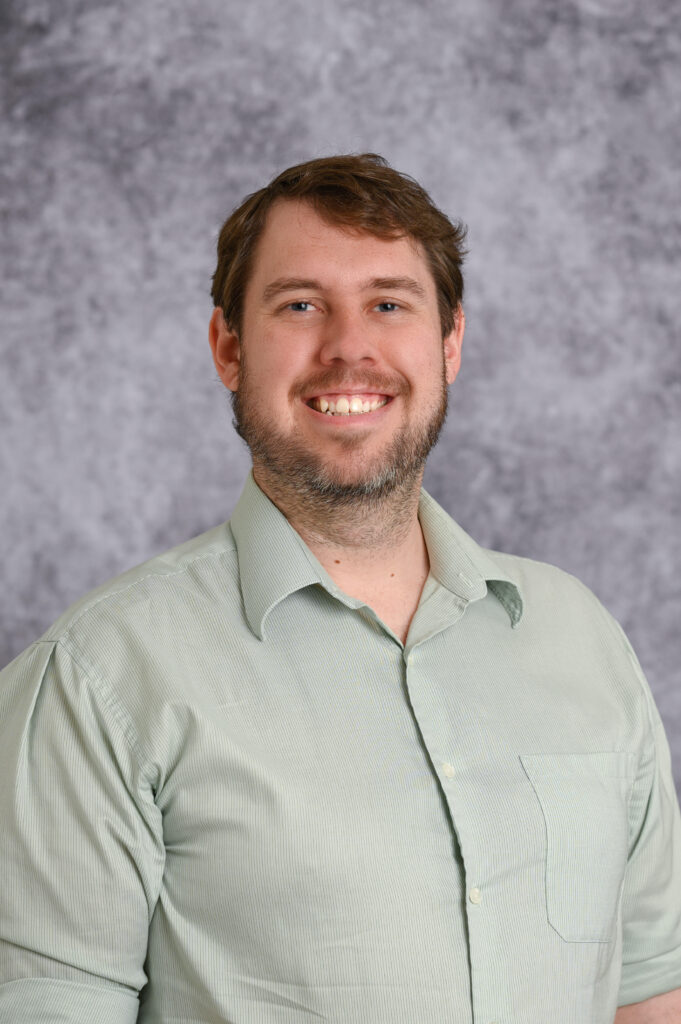Dr. Jacob T. Dums

Research Areas:
- Genetic Engineering (GE) of Algae
- GE of Viruses (phage & giant viruses)
- Algae Virus Discovery
- Viral Ecology/Metagenomics
- Virus Host Interactions
- Microbial Ecology
Techniques:
- Culture of algae, bacteria, and viruses
- Environmental sampling
- Viral isolation
- DNA/RNA extraction
- Genome sequencing
- Molecular cloning
- Plasmid design
- Genetic engineering of algae and viruses
- Bioinformatics (light)
Project Description:
Viruses are the most numerous biological entity on the planet; however most of what we know of virology is based upon a few model viruses. Those viruses also tend to be limited to pathogens of humans, crops, and livestock. Metagenomic sequencing from soil and water samples have revealed a vast diversity of viruses that infect microorganisms such as algae and bacteria. From the limited isolated viruses available, it has been found that these viruses control microbial populations, contribute to nutrient cycling in environments, and act as vectors for gene transfer. In order to expand our knowledge of virology we need to expand the types of viruses we have isolated and also develop molecular tools in order to explore the genetics driving virus host interactions.
For my projects, students will gain experience in hypothesis development, experimental design, experimental execution, data analysis, and dissemination of conclusions. I am currently working with 2 virus host systems at very different stages of establishment.
Chlorella GE and Virus Isolation: Photosynthetic microalgae like Chlorella are primary producers and form the base of the food chain in their environments. Additionally, Chlorella spp. have been extensively investigated as biofuel sources and are currently used in the biotech industry to produce specialty chemicals. Chlorella spp. are freshwater microalgae which are known to be infected by giant viruses (Van Etten and Dunigan 2016), but have until very recently lacked a genetic engineering system (Noel, Weeks, and Van Etten 2021). This project will include the isolation of new Chlorella giant algae viruses from local environments, adaptation of the published GE system, and development/testing of student-proposed Chlorella GE systems from the BIT 474/574: Plant Genetic Engineering course.
Modified from Figure 1 in (Van Etten and Dunigan 2016) Chlorella cells and chlorovirus Paramecium bursaria chlorella virus (PBCV-1). (A) Paramecium bursaria and its symbiotic chlorella cells. (B) Plaques formed by PBCV-1 on a lawn of Chlorella variabilis. (C) Five-fold averaged cryo-electron micrograph of PBCV-1 reveals a long narrow cylindrical spike structure at one vertex and fibers extending from one unique capsomer per trisymmetron.
Engineering phage with mutant DNA polymerases: E. coli is an ideal initial test system for virus host interaction hypotheses. One established hypothesis is a correlation between certain mutations in a virus-carried DNA polymerase gene (polA), and the viral lifestyle (Schmidt et al. 2014; Nasko et al. 2018). This hypothesis was generated by comparing the genomes of isolated viruses with known phenotypes and interactions to the diversity of viruses found in metagenomic surveys. Current research from my collaborating lab has biochemically characterized 31 diverse viral DNA polymerases to explore biochemical diversity in order to inform exploration of DNA polymerase diversity in in vivo systems (poster video) (Keown et al. 2022). The introduction of key mutations and diverse polymerases into the phage T7 virus genome will allow us to determine whether the patterns seen in metagenomic datasets truly yield the predicted phenotypes. In this project, the student will be assembling mutant T7 genomes using Golden Gate Cloning (Pryor et al. 2022) followed by synthesis in an in vitro transcription translation system (Rustad et al. 2017). Isolated mutant viruses will then be phenotyped to detect changes in the viral infection phenotype surrounding viral particle production and mutation rate.
References
Keown, Rachel A., Jacob T. Dums, Phillip J. Brumm, Joyanne MacDonald, David A. Mead, Barbra D. Ferrell, Ryan M. Moore, Amelia O. Harrison, Shawn W. Polson, and K. Eric Wommack. 2022. “Novel Viral DNA Polymerases From Metagenomes Suggest Genomic Sources of Strand-Displacing Biochemical Phenotypes.” Frontiers in Microbiology 13. https://doi.org/10.3389/fmicb.2022.858366
Nasko, Daniel J., Jessica Chopyk, Eric G. Sakowski, Barbra D. Ferrell, Shawn W. Polson, and K. Eric Wommack. 2018. “Family A DNA Polymerase Phylogeny Uncovers Diversity and Replication Gene Organization in the Virioplankton.” Frontiers in Microbiology 9 (December): 3053. https://doi.org/10.3389/fmicb.2018.03053.
Noel, Eric A., Donald P. Weeks, and James L. Van Etten. 2021. “Pursuit of Chlorovirus Genetic Transformation and CRISPR/Cas9-Mediated Gene Editing.” PloS One 16 (10): e0252696. https://doi.org/10.1371/journal.pone.0252696.
Pryor, John M., Vladimir Potapov, Katharina Bilotti, Nilisha Pokhrel, and Gregory J. S. Lohman. 2022. “Rapid 40 Kb Genome Construction from 52 Parts through Data-Optimized Assembly Design.” ACS Synthetic Biology, May. https://doi.org/10.1021/acssynbio.1c00525.
Rustad, Mark, Allen Eastlund, Ryan Marshall, Paul Jardine, and Vincent Noireaux. 2017. “Synthesis of Infectious Bacteriophages in an E. Coli-Based Cell-Free Expression System.” Journal of Visualized Experiments: JoVE, no. 126 (August). https://doi.org/10.3791/56144.
Schmidt, Helen F., Eric G. Sakowski, Shannon J. Williamson, Shawn W. Polson, and K. Eric Wommack. 2014. “Shotgun Metagenomics Indicates Novel Family A DNA Polymerases Predominate within Marine Virioplankton.” The ISME Journal 8 (1): 103–14. https://doi.org/10.1038/ismej.2013.124.
Van Etten, James L., and David D. Dunigan. 2016. “Giant Chloroviruses: Five Easy Questions.” PLoS Pathogens 12 (8): e1005751. https://doi.org/10.1371/journal.ppat.1005751.